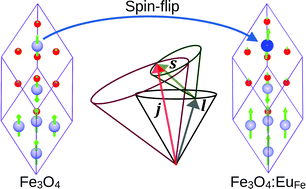Exceptionally high saturation magnetisation in Eu-doped magnetite stabilised by spin–orbit interaction†
Abstract
The significance of the spin–orbit interaction is very well known in compounds containing heavier elements such as the rare-earth Eu ion. Here, through density functional calculations, we investigated the effect of the spin–orbit interaction on the magnetic ground state of Eu doped magnetite (Fe3O4:EuFe). By examining all possible spin alignments between Eu and magnetite's Fe, we demonstrate that Eu, which is most stable when doped at the tetrahedral site, adapts a spin almost opposite the substituted Fe. Consequently, because of smaller spin cancellation between the cations on the tetrahedral site (FeTet and EuTet) and the cations on the octahedral sites (FeOct), Fe3O4:EuFe exhibits a maximum saturation magnetisation of 9.451 μB per f.u. which is significantly larger than that of undoped magnetite (calculated to be 3.929 μB per f.u.). We further show that this large magnetisation persists through additional electron doping. However, additional hole doping, which may unintentionally occur in Fe deficient magnetite, can reduce the magnetisation to values smaller than that of the undoped magnetite. The results presented here can aid in designing highly efficient magnetically recoverable catalysts for which both magnetite and rare earth dopants are common materials.



 Please wait while we load your content...
Please wait while we load your content...